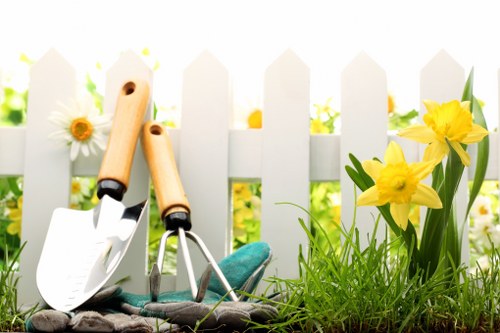Comprehensive Guide to Garden Fence Installation and Replacement
Introduction to Garden Fencing

Garden fencing serves multiple purposes, from enhancing the aesthetic appeal of your outdoor space to providing security and privacy. Whether you are installing a new fence or replacing an old one, understanding the various aspects involved is crucial for achieving the desired outcome.
Choosing the right type of fence depends on several factors, including the purpose of the fence, the style of your garden, and your budget. This guide will walk you through the essential steps and considerations for successful garden fence installation and replacement.
Proper installation not only ensures the longevity of your fence but also maximizes its functionality. In the following sections, we'll delve into the different materials, design options, and installation techniques to help you make informed decisions.
Types of Garden Fences

Selecting the appropriate fence type is the foundation of any successful garden fence project. Various materials offer different benefits and aesthetics, making it essential to choose one that aligns with your garden’s requirements.
Wooden Fences
Wooden fences are a popular choice due to their natural look and versatility. They can be customized in terms of height, design, and finish to complement any garden style.
Pros and Cons
- Pros: Aesthetic appeal, customizable, natural material.
- Cons: Requires regular maintenance, susceptible to weather damage.
Despite their beauty, wooden fences may need periodic treatments to prevent rot and decay, ensuring they remain sturdy and attractive over time.
Metal Fences
Metal fences, such as wrought iron or aluminum, are known for their durability and strength. They offer a classic look that can enhance the visual appeal of your garden.
Pros and Cons
- Pros: Durable, low maintenance, secure.
- Cons: Can be expensive, limited in terms of privacy.
Metal fences are ideal for those seeking a long-lasting solution with minimal upkeep. They are also effective in providing security while allowing visibility.
Planning Your Fence Installation

Effective planning is critical to the success of your fence installation or replacement project. It involves assessing your needs, understanding local regulations, and preparing the site for installation.
Assessing Your Needs
Determine the primary purpose of your fence. Are you looking for privacy, security, or simply to enhance the appearance of your garden? Understanding your needs will help you select the right material and design.
Measuring Your Space
Accurate measurements are essential to ensure that your fence fits perfectly within your garden space. Measure the perimeter carefully and account for any obstacles, such as trees or existing structures.
Understanding Local Regulations
Before commencing installation, familiarize yourself with local zoning laws and homeowners’ association guidelines. These regulations may dictate the height, material, and placement of your fence.
Permits and Approvals
In some areas, a permit may be required for fence installation. Ensure you obtain the necessary approvals to avoid potential fines or the need to modify your fence later.
Step-by-Step Installation Process

Installing a garden fence involves a series of steps that, when followed meticulously, can result in a sturdy and aesthetically pleasing fence.
Preparing the Site
Start by clearing the installation area of any debris, vegetation, or obstacles. Ensure the ground is level to facilitate uniform fence installation.
Marking the Fence Line
Use stakes and a string line to mark the exact location where the fence will be installed. This ensures straight and uniform placement of fence panels.
Installing Fence Posts
Fence posts are the backbone of your fence structure. Dig holes at regular intervals, typically 6-8 feet apart, ensuring they are deep enough to provide stability.
Setting the Posts
Place the posts in the holes, ensuring they are plumb and aligned with the string line. Backfill with concrete to secure the posts firmly in place.
Attaching Fence Panels or Rails
Once the posts are set, attach the fence panels or rails between them. Ensure each panel is level and securely fastened to prevent any sagging or movement.
Finishing Touches
After the panels are in place, add any decorative elements or treatments, such as staining or painting, to enhance the appearance and longevity of your fence.
Garden Fence Replacement Considerations

Over time, garden fences may deteriorate due to weather exposure, wear and tear, or other factors. Replacing an old fence involves assessing its condition and selecting the best replacement option.
Assessing Fence Condition
Examine your existing fence for signs of damage, such as rotting wood, rusted metal, or broken panels. Understanding the extent of the damage will help you decide whether to repair or replace the fence.
Choosing Replacement Materials
When replacing a fence, consider upgrading to a more durable material or one that better suits your current garden needs. This is an opportunity to enhance both functionality and aesthetics.
Environmental Impact
Consider the environmental implications of your fence replacement. Opting for sustainable materials can reduce your garden’s ecological footprint and contribute to long-term environmental health.
Recycling Old Materials
If possible, recycle or repurpose parts of your old fence. This not only minimizes waste but also provides an eco-friendly solution to fence replacement.
Maintenance Tips for Longevity
Regular maintenance can extend the life of your garden fence, keeping it looking fresh and functional for years to come.
- Inspect Regularly: Check for any signs of damage or wear and address issues promptly.
- Clean Periodically: Remove dirt, mold, and debris to prevent deterioration.
- Reapply Treatments: Repaint or stain wooden fences to protect them from the elements.
- Repair Damages: Replace broken panels or fix leaning posts to maintain fence stability.
By adhering to these maintenance practices, you ensure that your garden fence remains a valuable addition to your outdoor space.
Seasonal Care
Different seasons bring unique challenges. For instance, winters may require additional protection against freezing, while summers might necessitate extra cleaning after heavy rains.
Protecting Against Pests
Implement measures to deter pests like termites or rodents, which can cause significant damage to wooden fences. Regular inspections and treatments can prevent infestations.
Enhancing Aesthetic Appeal
A garden fence can significantly enhance the visual appeal of your outdoor space. Incorporate design elements that reflect your personal style and complement your garden’s overall theme.
Decorative Finishes
Adding decorative finishes such as lattice panels, ornamental post caps, or intricate stains can elevate the look of your fence.
Incorporating Greenery
Plant climbing vines or install trellises on your fence to add a touch of greenery and natural beauty. This not only enhances aesthetics but also provides additional privacy.
Lighting Solutions
Integrate outdoor lighting into your fence design to create a warm and inviting atmosphere during the evenings. Solar-powered lights are an energy-efficient option.
Functional Enhancements
Include elements like gates, pathways, or pergolas connected to your fence to add functionality and cohesiveness to your garden design.
Cost Considerations
Budgeting is a critical aspect of any garden fence project. Understanding the costs involved can help you make informed decisions and avoid unexpected expenses.
Material Costs
The type of material you choose will significantly impact the overall cost. For instance, wooden fences may be more affordable initially but require ongoing maintenance costs, whereas metal fences might have higher upfront costs but lower maintenance expenses.
Labor Expenses
Hiring professionals for fence installation or replacement can ensure quality work but will add to the overall cost. Alternatively, DIY installation can save money but requires time and effort.
Additional Features
Incorporate costs for additional features such as gates, decorative elements, and lighting during the planning phase to ensure they fit within your budget.
Long-Term Investment
Consider the long-term value of your fence. Investing in higher-quality materials and professional installation can result in a more durable and aesthetically pleasing fence, offering better value over time.
Choosing the Right Professionals
While DIY projects are appealing, hiring experienced professionals can ensure a flawless fence installation or replacement.
Researching Local Contractors
Look for reputable fence contractors in your area with positive reviews and a solid portfolio of completed projects.
Getting Multiple Quotes
Obtain quotes from several contractors to compare prices, services offered, and timelines. This helps you make an informed decision while ensuring competitive pricing.
Checking Credentials
Ensure that the contractors you consider are licensed, insured, and have a good standing with local business bureaus.
Reviewing Past Work
Ask for references or examples of previous fence installations to assess the quality and style of their work.
Common Challenges and Solutions
Fencing projects can encounter various challenges. Being prepared with solutions can help mitigate these issues effectively.
Uneven Terrain
Installing a fence on uneven ground can be tricky. Solutions include leveling the ground, using adjustable posts, or selecting fencing materials that can accommodate the terrain variations.
Regulatory Hurdles
Encountering unexpected regulations can delay your project. Ensure thorough research and obtain necessary permits beforehand to avoid these obstacles.
Poor Weather Conditions
Weather can impact the installation process. Plan your project during favorable weather conditions and have contingency plans for unexpected changes.
Material Availability
Ensure that the materials you need are readily available. Delays in material supply can postpone your installation schedule, so order in advance whenever possible.
Innovative Fence Designs
Modern fence designs offer a blend of functionality and creativity. Explore innovative ideas to give your garden a unique and contemporary look.
Living Fences
Living fences incorporate plants and greenery, creating a natural barrier that is both beautiful and eco-friendly.
Vertical Gardens
Vertical gardens use fence space effectively by growing plants vertically, enhancing privacy and adding vibrant colors to your garden.
Modular Fencing Systems
Modular systems allow for easy customization and expansion, making them ideal for gardens that may change over time.
Smart Fencing
Integrate technology into your fence with features like automated gates, lighting controls, and security systems for added convenience and safety.
Environmental Sustainability
Choosing sustainable fencing options contributes positively to the environment. Consider eco-friendly materials and practices in your fence installation or replacement.
Sustainable Materials
Opt for materials like bamboo, recycled metal, or sustainably sourced wood to reduce your garden’s environmental impact.
Eco-Friendly Practices
Implement practices such as minimizing waste, recycling old materials, and using non-toxic finishes to enhance the sustainability of your project.
Energy Efficiency
Incorporate elements like solar-powered lighting or insulated panels to improve the energy efficiency of your outdoor space.
Water Conservation
Design your fence to complement water conservation efforts, such as integrating it with rainwater harvesting systems or drought-resistant plants.
Conclusion
Garden fence installation and replacement are significant endeavors that can transform your outdoor space. By carefully selecting the right materials, planning meticulously, and maintaining your fence regularly, you can create a beautiful, functional, and enduring boundary for your garden.
Whether you are enhancing privacy, adding security, or simply improving the aesthetic appeal, a well-installed fence can make a substantial difference. Remember to consider your specific needs, budget, and environmental impact when undertaking your fencing project.
For professional assistance and quality fence installation services, contact us today and take the first step towards transforming your garden.
Book your service now to ensure a seamless and expert fence installation experience.